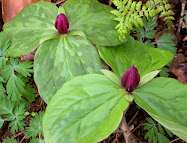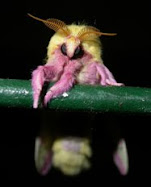I have been so busy lately and have not had a chance to share all of the exciting things I have seen lately. Last night I downloaded over 500 photos of moths that I had taken this month but I will save those for a later blog. Among them was another visit from a Luna moth.
I will try to take up where I last left off and that would be a trip to Cacapon State Park with my Naturalist friend who is surveying native bees for a National survey. Specifically we were looking for bees that pollinate blue berries. We found lots of Huckleberries and no Blueberries but that did not deter us. Our best location was this Wild Cherry tree that was laying on its side but was still alive and in full bloom. There were so many bees it was like a soft roar in our ears.
Besides bees I noticed this Eastern Tent Caterpillar nest full of colorful larva. I think there are beautiful; too bad they do so much destruction.
You can see the egg case that they came from. It is located just a little higher up on the same branch. They overwinter in these cases and emerge in the spring.
Here is a photo of one caught in the act of emerging that I took with my microscope. They are tiny and look like hairy mice poop.
A lot of Juvenal’s Duskywing butterflies (Erynnis juvenalis) were flying where I stoped on my way to Cacapon. I believe the first photo is a male. The females have bigger spots. In doing research on this species I discovered that Duskywings are named after Roman poets. Cool uh? Juvenal, as the English called him, was a Roman poet during the laste 1st and early 2nd centry AD and author of the Satires. His Roman name was Decimus Iunius Iuvenalis. Horace of Horace's Duskywing is another one in my area that comes to mind.
Juvenal’s Duskywing - male
I think this is the female Juvenal’s Duskywing.
In abundance were caterpillars of all sorts but most of them were still very young and hard to identify. Well, actually they were more than hard, I didn’t know what any of them were. My favorite of the day was this red one on the Cherry tree. Doesn’t it blend in well? You might want to click photo to see a larger view.
Here is another one in the typical inchworm crawl. It is a member of the Geometrid family the type that the migrating warblers are so fond of gobbling up. They also make good food for baby birds. They are soft and easy to digest and full of needed protein to grow. I’ve seen Carolina Wrens hold 5 or more in their bills to take back to the chicks. They look like someone holding a handful of those long skinny balloons.
I found this next one on the underside of a leaf. When I approached it with my camera it began tossing it's head back and forth like a little boy trying not to have his face washed.
I didn’t see a lot of new wildflowers but this small patch Birdfoot Violets (
Viola pedata) stood out. It was right next to the parkling lot.
Another blue flower that we were surprised to see was the Blue-eyed Grass. Sisyrinchium angustifolium as it is called in scientific terms is a member of the Iris Family.
Here is a new grasshopper for me. I almost didn’t see it because it blended in so well in the crevice of the tree that it was resting on. I believe it is the Robust Shieldback (Atlanticus gibbosus) but that doesn't make sense because I found it out of its range. I think it is a male because I don't see the ovipositor that the females use to dig a place to lay their eggs. Anyone else have an opinion?
And then there were the ever present mating insects, this week it was the Locust Leaf Miner,
Odontota dorsalis. The little one on top is the male.
Lastly I want to mention the lichen. I think this is Common Toadskin Lichen (
Lasallia papulosa) but I am not certain because I have not see the black dots (friuting body) on it before.
That day was one of discovering new species and seeing some familiar ones. I certainly didn't know everything that I found but it is the journey and exploration that is so exciting. The wonder of it all.



+7648++DSCN4674+blog.jpg)
++9065+DSCN4742+blog.jpg)
+9047+DSCN4747+blog.jpg)
+9062+DSCN4282+blog+tuffs.jpg)
+9049+DSCN4971+blog.jpg)
+DSCN4457+blog.jpg)

+IMG_6315.JPG)
+IMG_6407.JPG)
+IMG_6414.JPG)






































+DSCN5800+for+blog.jpg)



